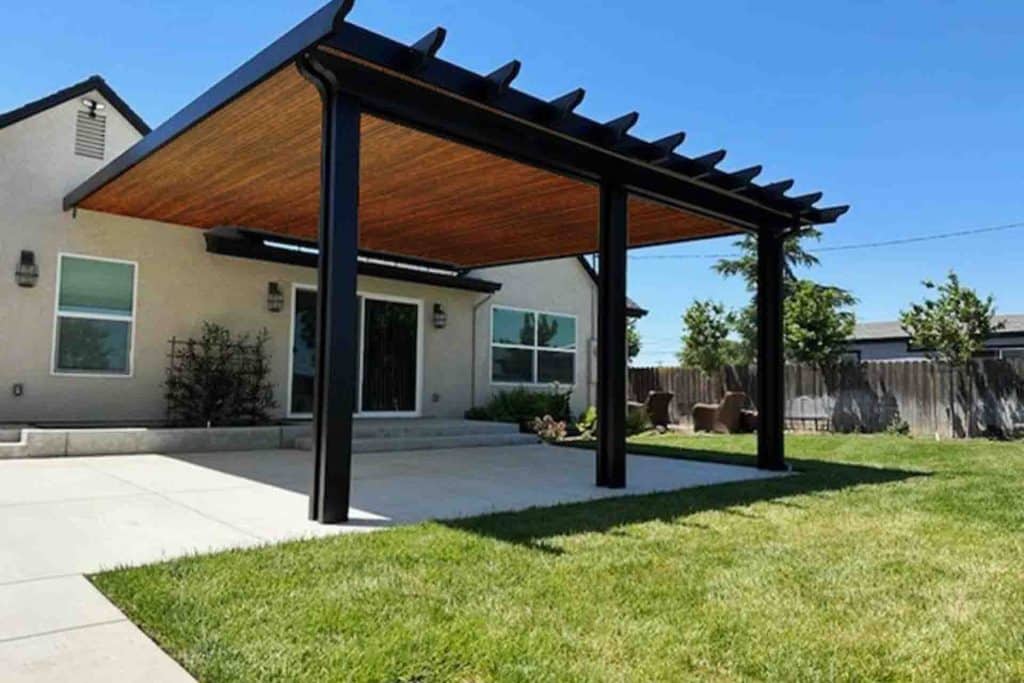
| Protect Your Patio Cover Today – Contact Us! |
Why Do Some Patio Covers Get Moldy?
- Humid air, dew, or rain can cause water droplets to linger on surfaces.
- If parts of the cover are tucked or have limited ventilation, spores settle and thrive.
- Leaves, pollen, dust, and dirt accumulate on the patio cover surface and act as feeding grounds for mold.
- If the paint, sealant, or protective coating on your patio cover is old or damaged, it can let tiny pores form on the surface where mold spores can settle and grow.
7 Practical Tips to Prevent Mold on Patio Covers
1. Choose the Right Material
Opt for high-grade, low-maintenance, mildew-resistant materials, for example, Aluminum. It doesn’t warp, rot, or support mold growth. If you’re installing an Aluminum patio cover, you can demand professional-grade powder coating. This finish adds an extra layer of water resistance and is easy to clean. Also, the cover should have built-in ventilation panels that allow air circulation. This keeps moisture from being trapped under the surface.2. Choose Design With Airflow & Drainage
When you’re looking for a patio cover installation, it’s not just the material; design choices can also make a big difference. You should discuss everything with your patio cover provider.- Check if flashing, drip edges, and gutters are designed to divert water away from the structural surfaces and underside.
- Avoid horizontal pockets or ledges where water can sit.
- Incorporate venting gaps or small louvers (if possible) to allow moisture-laden air to escape.
- Slope the roofing appropriately so water doesn’t run back toward the underside.
3. Regular Cleaning and Maintenance
Cleaning your patio covers from time to time is the best way to protect them. But you should know when and how to do it.|
Steps | What To Do | Tips |
|---|---|---|
| Frequency | Clean at least twice a year, mainly during the spring & fall. |
For damp or shaded areas, schedule quarterly wipe-downs to prevent buildup. |
|
Tools |
Use a soft-bristle brush or sponge. | Avoid wire brushes as they can scratch coatings and make surfaces prone to mold. |
| Cleaning Solutions | Mix mild soap + water or use a non-ionic cleaner. |
For mold spots, mix white vinegar and water (1:3 ratio) or use a commercial mildew cleaner. Let it sit 10-15 minutes, then rinse thoroughly. |
|
Drying |
After cleaning, let the cover dry completely in the sunlight. | UV rays help kill any remaining spores and reduce moisture buildup. |
| Joints & Hardware | Check bolts, brackets, seams, and corners for mold presence. |
Remove leaves, dirt, or debris. These areas often trap moisture and invite mold. |
| Call Now to keep your patio cover clean and mold-free! |
4. Monitor & Manage Moisture
Your patio cover will get wet sometimes, so you have to make sure that the moisture doesn’t stay for long.- After storms, inspect the underside for drips, puddles, or condensation. Wipe dry if possible.
- Don’t stack wet furniture or grills under the cover in a way that presses moisture against the surface.
- In high-humidity periods, run a fan or blow occasional air across surfaces to help dry them.
- Keep the surrounding landscaping trimmed so that plants don’t press against or block airflow under the cover.
5. Regular Inspection and Repairs
Even a small damage in the patio cover can become a mold gateway.- Check coatings yearly. Look for cracks, peeling, or dull patches.
- Re-seal or repaint minor damage before it becomes worse.
- Tighten or replace corroded hardware.
- If you see mold stains that won’t scrub off, consider light sanding and refinishing that patch.
6. Keep a Check on Furniture & Fabrics Below
While the main goal is protecting the cover itself, mold on furniture or cushions can spread spores to the overhead structure.- Keep your cushions clean and completely dry. Scrub, rinse, and dry them well, and use a mildew-resistant spray to protect the fabric.
- Store cushions and removable fabrics indoors or in a well-ventilated area during wet seasons.
- Don’t place potted plants with wet soil directly under the patio cover, as water or humidity can reach and damage the underside.
7. Know When to Call a Professional
If you see mold recurring rapidly or suspect structural damage, consider hiring experienced service providers near you. When selecting a patio cover contractor, you need to look for a few things.- They must have proven experience with patio cover installation in the local climate.
- Check their portfolio of custom patio covers in Roseville to check if they’ve handled complex shapes, gutters, and drainage.
- Their familiarity with aluminum patio covers, including coatings and finishes.
- Their willingness to inspect designs for ventilation, flashing, and drainage.
- They offer maintenance contracts or annual check-ups instead of just one-off installs.
Commonly Asked Questions About Mold in Patio Cover
Is vinegar strong enough to kill mold on outdoor structures?
Yes, many homeowners and cleaning guides use a 1:3 mixture of white vinegar to water. Let it sit, then scrub and rinse. But for heavy stains, you may need commercial cleaners or, in worst cases, light sanding and re-coating by professionals.
How often should I clean my patio cover to avoid mold?
Clean your patio cover at least twice a year. In damp, shaded, or coastal areas, it’s better to clean it every three months. The main goal is to prevent dirt and moisture from building up, because mold and mildew grow where surfaces stay wet or dirty.
Can mold on furniture spread to the cover above?
Yes, mold spores from cushions, rugs, or plants underneath can rise and settle on your patio cover. Keeping everything below clean and dry helps prevent mold from spreading to the cover.
Are aluminum patio covers completely mold-proof?
Aluminum resists mold, but it’s not completely immune. Dirt, leaves, or standing water can still let mold grow, so regular cleaning is necessary to keep it safe.
What’s better - DIY store-bought or custom covers?
Custom covers, when installed by professionals, fit better and last longer. They can address unique weather and drainage patterns and greatly reduce mold risk.
| Maintain your patio cover easily—Call to Schedule! |
Takeaway
A patio cover is more than just an aesthetic or shade structure. It’s an investment in your home and lifestyle. By using quality materials, maintaining smart design, and keeping up with regular monitoring and care, you can keep your patio cover mold-free and long-lasting. Always choose a reliable patio cover provider to ensure worry-free installation and top-quality results.Read More!
- How to Build a Pet-Friendly Patio Cover That Keeps Your Furry Friends Cool and Comfortable All Summer
- How Do You Cover Patio Furniture For Winter?
- What You Need to Know Before Building a Patio Cover?
- What Maintenance Do Patio Covers Require in Dry vs. Humid California Regions?




